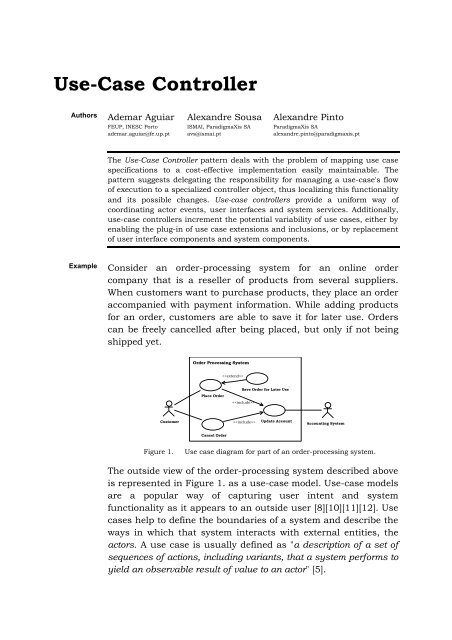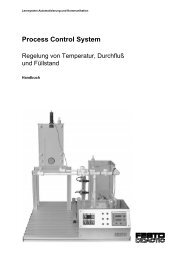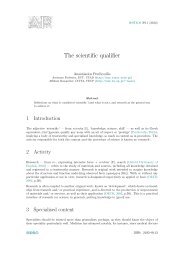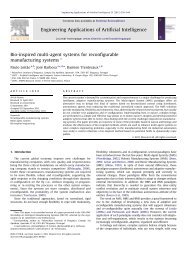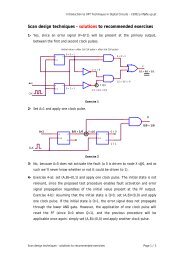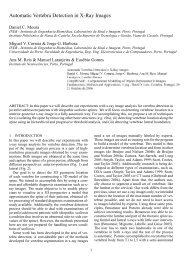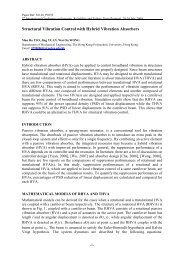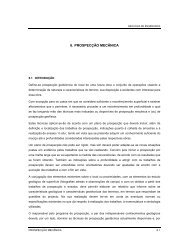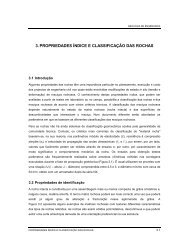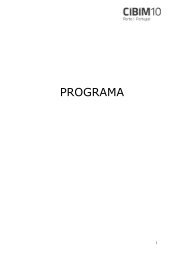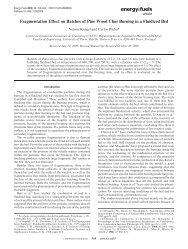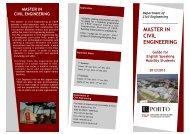Use-Case Controller
Use-Case Controller
Use-Case Controller
You also want an ePaper? Increase the reach of your titles
YUMPU automatically turns print PDFs into web optimized ePapers that Google loves.
<strong>Use</strong>-<strong>Case</strong> <strong>Controller</strong><br />
Authors<br />
Ademar Aguiar Alexandre Sousa Alexandre Pinto<br />
FEUP, INESC Porto ISMAI, ParadigmaXis SA ParadigmaXis SA<br />
ademar.aguiar@fe.up.pt avs@ismai.pt alexandre.pinto@paradigmaxis.pt<br />
The <strong>Use</strong>-<strong>Case</strong> <strong>Controller</strong> pattern deals with the problem of mapping use case<br />
specifications to a cost-effective implementation easily maintainable. The<br />
pattern suggests delegating the responsibility for managing a use-case's flow<br />
of execution to a specialized controller object, thus localizing this functionality<br />
and its possible changes. <strong>Use</strong>-case controllers provide a uniform way of<br />
coordinating actor events, user interfaces and system services. Additionally,<br />
use-case controllers increment the potential variability of use cases, either by<br />
enabling the plug-in of use case extensions and inclusions, or by replacement<br />
of user interface components and system components.<br />
Example<br />
Consider an order-processing system for an online order<br />
company that is a reseller of products from several suppliers.<br />
When customers want to purchase products, they place an order<br />
accompanied with payment information. While adding products<br />
for an order, customers are able to save it for later use. Orders<br />
can be freely cancelled after being placed, but only if not being<br />
shipped yet.<br />
Order Processing System<br />
<br />
Place Order<br />
Save Order for Later <strong>Use</strong><br />
<br />
Customer<br />
<br />
Update Account<br />
Accounting System<br />
Cancel Order<br />
Figure 1.<br />
<strong>Use</strong> case diagram for part of an order-processing system.<br />
The outside view of the order-processing system described above<br />
is represented in Figure 1. as a use-case model. <strong>Use</strong>-case models<br />
are a popular way of capturing user intent and system<br />
functionality as it appears to an outside user [8][10][11][12]. <strong>Use</strong><br />
cases help to define the boundaries of a system and describe the<br />
ways in which that system interacts with external entities, the<br />
actors. A use case is usually defined as "a description of a set of<br />
sequences of actions, including variants, that a system performs to<br />
yield an observable result of value to an actor" [5].
<strong>Use</strong>-<strong>Case</strong> <strong>Controller</strong> 2<br />
When mapping a use case model to an object-oriented<br />
implementation, several refinements and tasks are undertaken,<br />
such as: description of use cases, design of user-interfaces,<br />
identification of participating classes, and assignment of<br />
responsibilities to classes.<br />
As an example, for the Place Order use case we can produce<br />
the four different artefacts shown in Figures 2, 3, 4 and 5,<br />
corresponding respectively to: a brief textual description, an<br />
activity diagram, a diagram with the classes that participate in<br />
the use-case realization, and a draft of an user-interface.<br />
<strong>Use</strong> <strong>Case</strong><br />
Description<br />
Figure 2.<br />
Place Order<br />
The use case starts when a customer selects the option to<br />
place an order. The customer identifies himself to the<br />
system and enters the products he wants, for which the<br />
system supplies a description, price and a running total.<br />
After entering payment information, the customer is able to<br />
submit the order.<br />
The system then verifies the order submitted, saves it as<br />
pending, and forwards payment information to the<br />
accounting system.<br />
When the payment is confirmed, the order is marked<br />
confirmed, an order ID is sent to the customer, and the use<br />
case ends.<br />
Brief textual description of the Place Order use case.<br />
: Customer<br />
new order<br />
: OrdersSystem<br />
: Accounting System<br />
Display<br />
Order form<br />
Enter customer<br />
identification<br />
Entering<br />
identification<br />
Enter products<br />
Enter<br />
product<br />
Entering<br />
products<br />
Display product<br />
information and new total<br />
Submit<br />
order<br />
more products<br />
Order<br />
pending<br />
check account balance<br />
no more products<br />
Enter payment<br />
information<br />
Update<br />
account<br />
account is ok<br />
Checking<br />
account<br />
Entering payment<br />
information<br />
abort<br />
Abort<br />
order<br />
submit<br />
Order<br />
confirmed<br />
Display<br />
Order ID<br />
order aborted<br />
order placed<br />
Figure 3.<br />
Activity diagram of the Place Order use case.<br />
A use-case implementation is responsible for coordinating and<br />
sequencing the interactions between the system and its actors,<br />
Copyright © 2001 Ademar Aguiar, Alexandre Sousa and Alexandre Pinto.<br />
All rights reserved. Permission granted to copy for all purposes of EuroPLoP’2001.
<strong>Use</strong>-<strong>Case</strong> <strong>Controller</strong> 3<br />
while preserving the integrity of the data and the flow defined in<br />
the use case specification. Three different types of objects<br />
usually participate in a use-case realization, each one<br />
encapsulating a different kind of behaviour. These types were<br />
initially described in [8] and are now widely known and adopted<br />
by UML [5] as the stereotypes «boundary», «entity» and «control»:<br />
• interface objects are generally used to translate actor's<br />
actions to the system into events in the system, and<br />
vice-versa;<br />
• entity objects handle information that outlives use cases and<br />
are often persistent;<br />
• control objects encapsulate use case behaviour that is not<br />
naturally placed in any of the previous two types of objects,<br />
such as: coordination, sequencing, transaction, and control<br />
of other objects. Control objects usually last only during the<br />
execution of one particular use case.<br />
In Figure 4. are shown the classes participating in the realization<br />
of the Place Order use case along with their types.<br />
<strong>Use</strong>-<strong>Case</strong> Realization<br />
Place Order<br />
Update Account<br />
interface<br />
object<br />
control<br />
object<br />
Place Order<br />
Interface<br />
Place Order<br />
Manager<br />
Order<br />
Product<br />
Account<br />
Manager<br />
Accoun<br />
t<br />
entity<br />
object<br />
Figure 4.<br />
Classes participating in the realization of Place Order use case.<br />
In some situations, different users initiating the same Place<br />
Order use case may require different user interfaces, such as: a<br />
web interface for customers, graphical windows interface for<br />
customer reps, or a textual interface for typist operators. As a<br />
result, a use case implementation is often required to support<br />
easy replacement of user interface components and system<br />
components.<br />
Copyright © 2001 Ademar Aguiar, Alexandre Sousa and Alexandre Pinto.<br />
All rights reserved. Permission granted to copy for all purposes of EuroPLoP’2001.
<strong>Use</strong>-<strong>Case</strong> <strong>Controller</strong> 4<br />
Figure 5.<br />
<strong>Use</strong>r interface for the Place Order use case.<br />
Before coding an application modelled with use cases, many<br />
architectural and design decisions should be made. <strong>Use</strong> cases<br />
can be realized using a combination of three types of models:<br />
collaborations of subsystems and classes, state machines, and<br />
activity models [1][6]. <strong>Use</strong> case maps are another alternative that<br />
combines behaviour and structure in one view and shows the<br />
allocation of scenario responsibilities to system components<br />
[17][18].<br />
A use case implementation can be obtained using different<br />
approaches, with distinct impact in terms of modularity,<br />
coupling, reusability and changeability of the resulting code.<br />
Context<br />
Problem<br />
You are developing a medium-large system following a use-case<br />
driven approach.<br />
How do you design a use-case implementation?<br />
Independently of the way it is implemented, a use case must<br />
coordinate system actions in response to user actions and to<br />
take control over:<br />
• the events and input coming from user interface<br />
components;<br />
• the invocation of services provided by system components;<br />
• the execution of related use cases, such as extensions and<br />
inclusions, both helpful to improve modularity and<br />
reusability.<br />
Copyright © 2001 Ademar Aguiar, Alexandre Sousa and Alexandre Pinto.<br />
All rights reserved. Permission granted to copy for all purposes of EuroPLoP’2001.
<strong>Use</strong>-<strong>Case</strong> <strong>Controller</strong> 5<br />
In the development of a family of applications, it is also desirable<br />
to have use-case implementations reusable across several<br />
applications, although combined and configured in different<br />
ways [9].<br />
Forces<br />
Solution<br />
A solution to such a design problem should balance the<br />
following forces:<br />
• A use case implementation should preserve the integrity of<br />
the use case flow specification.<br />
• The same use case implementation should be executable<br />
with different user interfaces and system components,<br />
regarding that they satisfy the requirements given by the use<br />
case.<br />
• The behaviour of a use case implementation should be easily<br />
configurable with other use cases, either by extending it or<br />
by replacing some of its parts.<br />
• <strong>Use</strong> case implementations should be flexibly assembled<br />
together in several configurations to build different<br />
applications, once ensured that their implementations are<br />
compatible in terms of user interfaces and system services<br />
requirements.<br />
• A use case implementation should be easy to relate to the<br />
corresponding use-case model and thus preserve the<br />
traceability to and back earlier development models.<br />
The pattern suggests delegating the responsibility of managing<br />
the use case flow of execution to a dedicated use-case controller<br />
object, which requests services both from model objects and view<br />
objects:<br />
• controller objects manage the flow of interactions between<br />
users and system, and coordinate associated views, models<br />
and related use cases (inclusions, extensions);<br />
• model objects provide a single interface to a set of entity<br />
objects that encapsulate system information and behaviour<br />
outliving a use case execution;<br />
• view objects wrap boundary objects through which users<br />
communicate with the system, and inversely.<br />
Copyright © 2001 Ademar Aguiar, Alexandre Sousa and Alexandre Pinto.<br />
All rights reserved. Permission granted to copy for all purposes of EuroPLoP’2001.
<strong>Use</strong>-<strong>Case</strong> <strong>Controller</strong> 6<br />
View<br />
<strong>Controller</strong><br />
Place Order<br />
Account<br />
Customer<br />
Place Order<br />
Model<br />
Order Product Account<br />
Figure 6.<br />
Relationships between object types and MVC metaphor.<br />
The controller is the component responsible for ensuring the<br />
correct flow of a use case, both its basic thread and its variants.<br />
A controller receives meaningful events from components and,<br />
based on the use case specification, decides the valid sequence<br />
of action steps to perform. The internal state of a controller<br />
records the execution of a particular scenario, thus knowing why<br />
it was performed. A controller is also responsible for managing<br />
the associations with other participating components, namely<br />
the model, views and other related use cases (extensions,<br />
inclusions, generalizations).<br />
Model objects can be described as facades [3] to sets of services<br />
eventually distributed by several subsystems. Although many<br />
different services can be included in this interface, the intent is<br />
to include only those strictly needed to implement the<br />
corresponding use case. A first outline of these facades can be<br />
derived from the classes that participate in the use case.<br />
Views are interface objects needed by the use-case<br />
implementation to communicate information to the user. Views<br />
are responsible for the translation of user actions to events<br />
meaningful from the point of view of the use-case specification.<br />
In other words, views support bi-directional communication<br />
between the system and its users.<br />
The solution proposed in this pattern follows the guidelines for<br />
designing use case realizations presented in [8][9][7] and<br />
specializes the Model-View-<strong>Controller</strong> pattern [4] for the specific<br />
purpose of controlling the flow of a use case.<br />
Copyright © 2001 Ademar Aguiar, Alexandre Sousa and Alexandre Pinto.<br />
All rights reserved. Permission granted to copy for all purposes of EuroPLoP’2001.
<strong>Use</strong>-<strong>Case</strong> <strong>Controller</strong> 7<br />
Structure<br />
The <strong>Use</strong>-<strong>Case</strong> <strong>Controller</strong> pattern defines five types of participants:<br />
<strong>Use</strong><strong>Case</strong><strong>Controller</strong>, Model, View, Extension and Inclusion.<br />
Class<br />
<strong>Use</strong><strong>Case</strong><strong>Controller</strong><br />
Responsibilities<br />
• Ensures the<br />
correct execution<br />
of an use case<br />
• Handles use case<br />
events from views<br />
and models<br />
Collaborations<br />
• View<br />
• Model<br />
• Extension<br />
• Inclusion<br />
An instance of <strong>Use</strong><strong>Case</strong><strong>Controller</strong> is an object that encapsulates<br />
the knowledge needed to ensure the correct execution of one<br />
particular use case specification: sequence of action steps,<br />
states, preconditions, post-conditions, and components, both for<br />
accepting user input and for performing system services.<br />
As a rule of thumb, one <strong>Use</strong><strong>Case</strong><strong>Controller</strong> will be designed for<br />
each use case. When a use case is started, one instance of the<br />
corresponding use-case controller is created to control the flow<br />
of the interactions involved. Depending on the size and<br />
complexity of the controller, one might decide to create several<br />
use-case controllers for a particular use case, or the opposite.<br />
A use-case controller is not intended to interact directly with<br />
either interface objects or system objects, but only to Model and<br />
View objects, thereby promoting some layering at use-case level.<br />
Class<br />
Collaborations<br />
Class<br />
Collaborations<br />
Model<br />
Responsibilities<br />
• <strong>Use</strong>-case<br />
<strong>Controller</strong><br />
View<br />
Responsibilities<br />
• <strong>Use</strong>-case<br />
<strong>Controller</strong><br />
• Provides system<br />
information and<br />
functionality<br />
needed during<br />
use case<br />
execution<br />
• Presents<br />
information to<br />
actors<br />
• Receives actors<br />
input<br />
A use-case controller is typically associated with a Model facade,<br />
through which it has access to the subset of data and<br />
functionality needed to perform system-related actions. On the<br />
other hand, to communicate with the actors, a use-case<br />
controller relies on View facades. A View is usually an<br />
aggregation of several interface objects, such as windows, menus<br />
and buttons, dialogs and communication protocols.<br />
Copyright © 2001 Ademar Aguiar, Alexandre Sousa and Alexandre Pinto.<br />
All rights reserved. Permission granted to copy for all purposes of EuroPLoP’2001.
<strong>Use</strong>-<strong>Case</strong> <strong>Controller</strong> 8<br />
<strong>Use</strong> case inclusions and extensions can be mapped directly to an<br />
implementation by connecting a use-case controller with other<br />
use-case controllers through two kinds of hook objects.<br />
Class<br />
Collaborations<br />
Class<br />
Collaborations<br />
Extension<br />
• <strong>Use</strong>-case<br />
<strong>Controller</strong><br />
Inclusion<br />
• <strong>Use</strong>-case<br />
<strong>Controller</strong><br />
Responsibilities<br />
• Implements the<br />
<br />
association<br />
• Knows when and<br />
where the<br />
extension is valid<br />
Responsibilities<br />
• Implements the<br />
<br />
association<br />
• Knows where the<br />
inclusion is to be<br />
done<br />
Using an Extension hook, a use-case controller can be connected<br />
with others in order to augment its behaviour at predefined<br />
points and situations. Extensions can interrupt the execution of<br />
its base use-case and are usually triggered by conditions<br />
internal to the base use-case controller, either at defined<br />
extension points or during its overall execution. Base use-case<br />
controllers do not need to know their extensions.<br />
An Inclusion hook is similar to an extension, except that its<br />
execution is always used to realize the behaviour of the base<br />
use-case. Inclusions are known by the caller use-case controller<br />
[8][5]0, and initiated when needed during the execution flow of<br />
the base use-case. Base use-case controllers must know their<br />
inclusions.<br />
In addition to including and extending relationships, use cases<br />
can also be related by generalization relationships, which mean<br />
that a use case may specialize a more general one 0. This kind of<br />
relationship between use cases can be implemented by<br />
inheritance of use-case controllers, models and views, thus it is<br />
easily accommodated by the solution proposed.<br />
Hook<br />
call()<br />
Extension<br />
0..n<br />
caller binding<br />
0..n<br />
Inclusion<br />
callee<br />
0..1<br />
<strong>Use</strong><strong>Case</strong><strong>Controller</strong><br />
preconditions<br />
postconditions<br />
state<br />
start()<br />
doActionA()<br />
receivedEventX()<br />
finish()<br />
0..n 0..n<br />
0..n<br />
View<br />
Model<br />
data<br />
0..n<br />
preconditions<br />
Figure 7.<br />
Class diagram representative of the pattern structure.<br />
Copyright © 2001 Ademar Aguiar, Alexandre Sousa and Alexandre Pinto.<br />
All rights reserved. Permission granted to copy for all purposes of EuroPLoP’2001.
<strong>Use</strong>-<strong>Case</strong> <strong>Controller</strong> 9<br />
In Figure 7. it is shown the UML class diagram representative of<br />
the pattern structure.<br />
Implementation<br />
?<br />
?<br />
The following guidelines are suggested to implement this pattern.<br />
Identify candidate use cases by looking in the use case model for<br />
those that may benefit from the solution proposed by this<br />
pattern. <strong>Use</strong> cases usually involve interface objects and entity<br />
objects. In a first approach, all use cases can be defined as<br />
candidates. However, use cases whose behaviour is completely<br />
placed in interface objects and entity objects do not need to be<br />
implemented with use-case controllers because no behaviour is<br />
left to the control object. The same happens when one decide<br />
that control objects are better encapsulated within interface<br />
objects. On the other hand, a control object can be so complex<br />
that it is better to encapsulate it in two or more use-case<br />
controllers. Examples of functionality typically placed in usecase<br />
controllers are transaction-related behaviour, sequencing<br />
behaviour specific to one or more use cases, or behaviour to<br />
couple together interface objects and entity objects [8].<br />
* In the example presented, Place Order can be considered a<br />
good use case candidate, as it involves specific<br />
functionality that do not assign well either to interface<br />
objects or entity objects. On the other hand, the use case<br />
Save Order for Later <strong>Use</strong> is not a good candidate because its<br />
behaviour is very simple and do not involve coordination of<br />
interface objects and entity objects.<br />
For each one of the use cases above create a use-case controller<br />
class. Although being possible, and sometimes convenient, to<br />
create a use-case controller class for each use case candidate,<br />
this decision must be made by the developer after refinement of<br />
the use-case participant classes and, thus, knowing well the<br />
events exchanged between them. At this stage, it can be decided<br />
to assign one, two or more use-case controllers to a single usecase,<br />
or even none. Typically, a use-case controller class<br />
includes methods to start and finish its execution, to invoke<br />
specific use-case actions, and to fire events to interface objects<br />
and entity objects.<br />
* The use-case Place Order can be conveniently implemented with<br />
one single use-case controller class.<br />
abstract public class <strong>Use</strong><strong>Case</strong><strong>Controller</strong> {<br />
abstract public void start();<br />
abstract public void finish();<br />
}<br />
Copyright © 2001 Ademar Aguiar, Alexandre Sousa and Alexandre Pinto.<br />
All rights reserved. Permission granted to copy for all purposes of EuroPLoP’2001.
<strong>Use</strong>-<strong>Case</strong> <strong>Controller</strong> 10<br />
public class PlaceOrder<strong>Use</strong><strong>Case</strong> extends <strong>Use</strong><strong>Case</strong><strong>Controller</strong> {<br />
…<br />
public void start() { displayForm(); }<br />
public void finish() { … }<br />
public void displayForm() { … }<br />
public void setCustomerInfo(String name, String address) { …<br />
}<br />
public void newItem() { … }<br />
public void saveItem(String item) { … }<br />
public void deleteItem() { … }<br />
public void setPaymentInfo(String paymentType) { … }<br />
public void submitOrder() { … }<br />
public void cancelOrder() { … }<br />
}<br />
?<br />
Create the model and view objects needed to implement each use<br />
case. <strong>Use</strong>-case controller classes are responsible to coordinate<br />
the communication between entity objects and interface objects.<br />
After analysing the classes needed to perform the use case's flow<br />
of events, the behaviour must then be distributed to the<br />
interacting objects. All participating classes can be divided at<br />
least in two groups: a model, aggregating all entity objects; and<br />
views, which aggregate interface objects.<br />
Different strategies can be used to allocate the functionality to<br />
entity objects, interface objects and control objects [7][8]. The<br />
strategy to choose must be decided from application to<br />
application. In most cases, the balanced strategy, where control<br />
is placed separately from both interface and entity objects, is the<br />
one that reaches higher locality in changes of the functionality.<br />
* The model for Place Order use case can be simply obtained by<br />
providing a common access-point to the entity objects needed,<br />
as shown in the code below, or including also helper methods<br />
that make more convenient the usage of the model, such as<br />
methods for automating data conversions. Views may be<br />
obtained using a similar approach.<br />
public class PlaceOrderDialog extends javax.swing.JDialog<br />
{<br />
PlaceOrder<strong>Use</strong><strong>Case</strong> use<strong>Case</strong>;<br />
public PlaceOrderDialog(<strong>Use</strong><strong>Case</strong><strong>Controller</strong> use<strong>Case</strong>) {<br />
this(null);<br />
this.use<strong>Case</strong> = use<strong>Case</strong>;<br />
…<br />
submit.setText("Submit order");<br />
submit.addActionListener(new<br />
java.awt.event.ActionListener() {<br />
public<br />
actionPerformed(java.awt.event.ActionEvent event) {<br />
use<strong>Case</strong>.submitOrder();<br />
}<br />
});<br />
}}<br />
public class PlaceOrderModel {<br />
public Order order;<br />
void<br />
Copyright © 2001 Ademar Aguiar, Alexandre Sousa and Alexandre Pinto.<br />
All rights reserved. Permission granted to copy for all purposes of EuroPLoP’2001.
<strong>Use</strong>-<strong>Case</strong> <strong>Controller</strong> 11<br />
}<br />
public Vector products;<br />
public Vector paymentTypes;<br />
?<br />
Create extension and inclusion hooks for related use cases.<br />
Extensions and inclusions can be simply implemented with<br />
direct calls between use cases. Extension and inclusion hooks<br />
must be implemented when pretending to connect use-case<br />
implementations at run-time. In these cases, some<br />
implementation mechanism must be supported by use-case<br />
components for achieving the effect of plug-points and plug-ins.<br />
<strong>Use</strong>-case inclusions can be connected only at predefined plugpoints<br />
of the base use-case, but use-case extensions can be<br />
connected at any point, assuming they satisfy the requirements<br />
of the base use-case.<br />
* For clarity reasons, the example presented here is very<br />
simple and do not justify the implementation of a plug-in<br />
mechanism. However, both inclusion and extension hooks are<br />
implemented to demonstrate here a simple way of supporting<br />
hooks in the Place Order use-case.<br />
public class PlaceOrder<strong>Use</strong><strong>Case</strong> extends <strong>Use</strong><strong>Case</strong><strong>Controller</strong> {<br />
…<br />
Hook updateAccount = null;<br />
Vector extensionHooks = new Vector();<br />
…<br />
public void connectUpdateAccount(<strong>Use</strong><strong>Case</strong><strong>Controller</strong> use<strong>Case</strong>)<br />
{<br />
updateAccount = new Hook(use<strong>Case</strong>);<br />
}<br />
public void connectExtension(<strong>Use</strong><strong>Case</strong><strong>Controller</strong> use<strong>Case</strong>) {<br />
extensionHooks.add(new Hook(use<strong>Case</strong>));<br />
}<br />
public void submitOrder() {<br />
…<br />
updateAccount.call();<br />
…<br />
}<br />
}<br />
Copyright © 2001 Ademar Aguiar, Alexandre Sousa and Alexandre Pinto.<br />
All rights reserved. Permission granted to copy for all purposes of EuroPLoP’2001.
<strong>Use</strong>-<strong>Case</strong> <strong>Controller</strong> 12<br />
?<br />
Package use-case controllers using a similar organization as the<br />
underlying use-case model. One of the benefits of implementing<br />
use-case realizations using use-case controllers is that the code<br />
can be traced back to the originating use-case model. In systems<br />
with many use cases it may help to package use-case controllers<br />
using similar criteria to the one followed in the use-case model,<br />
thus creating a use-case layer at the application logic layer.<br />
: Customer<br />
: PlaceOrder<strong>Use</strong><strong>Case</strong> : PlaceOrderDialog : PlaceOrderModel updateAccountHook : updateAccount :<br />
Hook<br />
UpdateAccount<strong>Use</strong><strong>Case</strong><br />
start( )<br />
setCustomerInfo(String, String)<br />
connectUpdateAccount()<br />
displayForm( )<br />
show()<br />
new(updateAccount)<br />
newItem( )<br />
newItem( )<br />
addProduct()<br />
addProduct()<br />
setPaymentInfo(String)<br />
submitOrder()<br />
call()<br />
start()<br />
finish()<br />
finish( )<br />
Figure 8.<br />
Sequence diagram for the Place Order use case example.<br />
Consequences<br />
The <strong>Use</strong>-<strong>Case</strong> <strong>Controller</strong> pattern provides the following benefits:<br />
• Localization of business rules and policies. <strong>Use</strong>-case<br />
controllers work as glue between user interfaces and domain<br />
entities and place much of the application logic separate<br />
from dialogue and system components. Therefore, it will be<br />
easier to incorporate changes without affecting interfaces,<br />
system objects or database schemas, because future changes<br />
of the functionality will have a high locality in use-case<br />
controllers.<br />
• Easy replacement of user interfaces and system components.<br />
<strong>Use</strong>-case controllers are separated from the user interface<br />
and system components. Therefore, multiple user interface<br />
components and system components can be implemented<br />
and used by a single controller, and can be easily substituted<br />
statically and dynamically.<br />
Copyright © 2001 Ademar Aguiar, Alexandre Sousa and Alexandre Pinto.<br />
All rights reserved. Permission granted to copy for all purposes of EuroPLoP’2001.
<strong>Use</strong>-<strong>Case</strong> <strong>Controller</strong> 13<br />
• Visibility of the originating use case model in the<br />
implementation code. The pattern suggests a straightforward<br />
design and implementation of use-case realizations.<br />
Assuming that the pattern is consistently instantiated<br />
following some coding convention, use-case implementations<br />
will be easy to recognize at the code level and to be traced<br />
back to the respective model.<br />
• Flexible configuration of applications using pluggable use case<br />
implementations. <strong>Use</strong>-case controllers encapsulate the most<br />
important functionality specified in the use case, and can be<br />
easily replaced even at run-time. Therefore, the pattern<br />
allows the configuration of applications by plug-in of use<br />
case components having use-case controllers at their heart.<br />
In contrast, the pattern imposes the following liabilities:<br />
• Increased number of classes. As the pattern introduces a<br />
conceptual separation between user interface, model and<br />
controller objects, more classes are needed to implement the<br />
same functionality. This aspect must be considered having in<br />
mind the benefits of an increased separation of concerns and<br />
changeability versus the dimension of the system at hands.<br />
• Increased complexity. The pattern suggests the assignment of<br />
a control object for each use case, which can result in code<br />
more complex than the original. When the use-case<br />
behaviour is not complex enough to justify the usage of a<br />
separate control object, the control object should be avoided.<br />
• Control flow of the application slightly harder to trace directly<br />
from a strict reading of the code as one must be aware of the<br />
design principles and coding convention that lead to the<br />
application logic being organized around the concept of use<br />
cases. On the other hand, once known the underlying usecase<br />
model, the readability and modularity of the<br />
implementation is largely improved.<br />
• Close relation between models and views to controllers.<br />
<strong>Controller</strong>s directly invoke functionality from models and<br />
views, thus implying that changes to interfaces of models<br />
and views may have impact on controllers.<br />
• Potential instability of the implementation mainly when the<br />
underlying use case model is unstable or badly organized.<br />
For these situations it may help to decompose use-cases into<br />
Copyright © 2001 Ademar Aguiar, Alexandre Sousa and Alexandre Pinto.<br />
All rights reserved. Permission granted to copy for all purposes of EuroPLoP’2001.
<strong>Use</strong>-<strong>Case</strong> <strong>Controller</strong> 14<br />
more fine-grained components, usually called actions [8] or<br />
action steps 0, which are generally more stable as they<br />
closely map from essential system requirements. The<br />
aggregation of these actions around use-cases can improve<br />
usability but at the cost of being more specific and<br />
constrained. Therefore, it is important to separate this usecase<br />
layer from the overall application logic, to improve<br />
system changeability.<br />
Related<br />
Patterns<br />
MODEL-VIEW-CONTROLLER [4] differs from this pattern, because its<br />
applicability is wider and thus less useful for the particular<br />
problem of implementing use case realizations.<br />
COMPOSITE and FACADE [3] may be used to combine several user<br />
interface components or views in one single object. The same<br />
applies for entity objects and models, respectively.<br />
ADAPTER [3] can help on the conversion of interfaces of system<br />
and user interface components. BRIDGE [3] can decouple user<br />
interface abstractions from their implementation so that both<br />
can vary independently without disrupting use-case controller's<br />
interfaces.<br />
<strong>Use</strong>-case controllers can be implemented using the COMMAND [3]<br />
or COMMAND PROCESSOR [4] patterns so that their execution may<br />
be started uniformly using a single method.<br />
CHAIN OF RESPONSIBILITY [3] or BUREAUCRACY [16] can be useful for<br />
implementing the handling of requests on a use-case controller.<br />
J2EE patterns catalogue [19] include FRONT CONTROLLER, SESSION<br />
FACADE, DISPATCHER, COMPOSITE VIEW and AGGREGATE ENTITY<br />
patterns, all of them related to the problem dealt by this pattern,<br />
but not so adapted to the realization of use-cases. FRONT<br />
CONTROLLER and DISPATCHER, both together, aggregate<br />
functionality similar to that of use-case controller. FRONT<br />
CONTROLLER provides a centralized controller for handling<br />
requests and it typically works in coordination with a DISPATCHER<br />
component, responsible for view management and navigation.<br />
SESSION FACADE deals with the problem of reducing the number<br />
of use-case controller objects when implementing each use-case<br />
as a session bean. COMPOSITE VIEW and AGGREGATE ENTITY<br />
simplify the handling of multiple views and multiple entities by<br />
aggregating them in a uniform composite object, thus having a<br />
Copyright © 2001 Ademar Aguiar, Alexandre Sousa and Alexandre Pinto.<br />
All rights reserved. Permission granted to copy for all purposes of EuroPLoP’2001.
<strong>Use</strong>-<strong>Case</strong> <strong>Controller</strong> 15<br />
role similar to the view and model participants defined in this<br />
pattern.<br />
Known <strong>Use</strong>s<br />
Credits<br />
In [7][8][9] are presented several examples of using controllers to<br />
manage the flow of use cases, although they are not detailed at<br />
the code level, but only at a design level.<br />
SIMATWARE application framework [15] provides a dynamic<br />
configuration of applications based on the plug-in of use case<br />
components implemented with use-case controllers.<br />
JAVA 2 ENTERPRISE EDITION has many uses of this pattern<br />
documented in [19]. J2EE PATTERNS catalogue includes specific<br />
patterns to help solving some of the problems that arise when<br />
instantiating this pattern to J2EE platform, namely: FRONT<br />
CONTROLLER, SESSION FACADE, DISPATCHER, COMPOSITE VIEW and<br />
AGGREGATE ENTITY patterns.<br />
Thanks to those who had contributed to this work, for their<br />
ideas and critics on its early drafts, specially, Gabriel David and<br />
José Bonnet.<br />
Special credits goes to Kevlin Henney, our EuroPLoP’2001<br />
shepherd, and Alan O'Callaghan, Amir Raveh, Frank<br />
Buschmann, Jens Coldwey, Klaus Marquardt, Kristian Elof<br />
Sørensen for the inspiring questions and valuable feedback to<br />
this pattern during the writer's workshop.<br />
Copyright © 2001 Ademar Aguiar, Alexandre Sousa and Alexandre Pinto.<br />
All rights reserved. Permission granted to copy for all purposes of EuroPLoP’2001.
<strong>Use</strong>-<strong>Case</strong> <strong>Controller</strong> 16<br />
References<br />
[1] A. Cockburn, Writing Effective <strong>Use</strong> <strong>Case</strong>s, Addison-Wesley, 2000.<br />
[2] D. Rosenberg, K. Scott, <strong>Use</strong> <strong>Case</strong> Driven Object Modelling with UML: A Practical<br />
Approach, Addison Wesley Longman, 1999.<br />
[3] E. Gamma, R. Helm, R. Johnson, and J. Vlissides, Design Patterns – Elements of<br />
Reusable Object-Oriented Software, Addison-Wesley, 1995.<br />
[4] F. Buschmann, R. Meunier, H. Rohnert, P. Sommerlad, M. Stal, Pattern Oriented<br />
Software Architecture – a System of Patterns, John Wiley and Sons, 1996.<br />
[5] G. Booch, J. Rumbaugh, I. Jacobson. The Unified Modelling Language <strong>Use</strong>r Guide.<br />
Addison-Wesley, 1999.<br />
[6] G. Booch, J. Rumbaugh, I. Jacobson. The Unified Modelling Language, version 1.3,<br />
Object Management Group, June 1999.<br />
[7] I. Jacobson, G. Booch, J. Rumbaugh. The Unified Software Development Process,<br />
Addison-Wesley, 1999.<br />
[8] I. Jacobson, M. Christerson, P. Jonsson, and G. Övergaard, Object-Oriented Software<br />
Engineering: A <strong>Use</strong> <strong>Case</strong> Driven Approach, Addison-Wesley, Reading, Massachusetts,<br />
1992.<br />
[9] I. Jacobson, M. Griss, P. Jonsson, Software Reuse: Architecture, Process and<br />
Organization for Business Success, Addison-Wesley, Reading, Massachusetts, 1997.<br />
[10] I. Jacobson, S. Bylund, P. Jonsson, Using Contracts and <strong>Use</strong> <strong>Case</strong>s to Build Pluggable<br />
Architectures, JOOP, May-June, 1995.<br />
[11] I. Jacobson, <strong>Use</strong> <strong>Case</strong>s in Large-Scale Systems, ROAD, March-April 1995.<br />
[12] J. Rumbaugh, Getting Started: Using use cases to capture requirements, JOOP,<br />
September 1994.<br />
[13] K. Henney, Design - Concepts and Practices, ACCU Conference, www.accu.org,<br />
September 1999.<br />
[14] OMG. Unified Modeling Language Specification, Object Management Group,<br />
www.omg.org, 1998.<br />
[15] ParadigmaXis. SIMATWARE Application Framework, Internal Report, ParadigmaXis SA,<br />
March 2001.<br />
[16] R. C. Martin, D. Riehle, and F. Buschmann, Pattern Languages of Program Design 3,<br />
Addison-Wesley, 1997.<br />
[17] R.J.A. Buhr, and R.S. Casselman: <strong>Use</strong> <strong>Case</strong> Maps for Object-Oriented Systems,<br />
Prentice-Hall, USA, 1995.<br />
[18] R.J.A. Buhr, <strong>Use</strong> <strong>Case</strong> Maps as Architectural Entities for Complex Systems, in<br />
Transactions on Software Engineering, IEEE, December 1998.<br />
[19] SJC, J2EE Patterns, Sun Java Center, java.sun.com, March 2001.<br />
Copyright © 2001 Ademar Aguiar, Alexandre Sousa and Alexandre Pinto.<br />
All rights reserved. Permission granted to copy for all purposes of EuroPLoP’2001.


